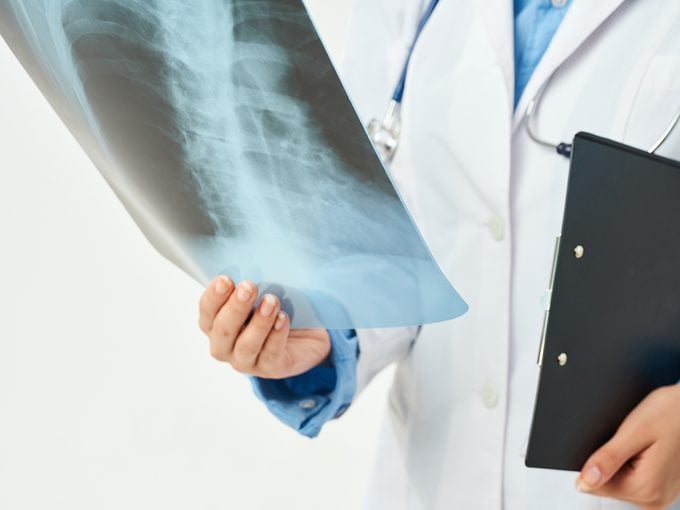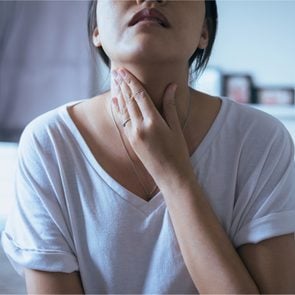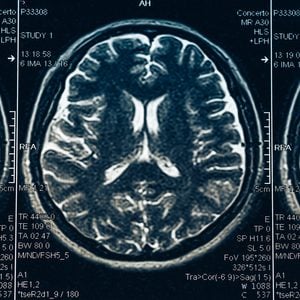A Woman’s X-Ray Reveals the Astonishing Reason for Her Lifetime of Stomach Pain
The x-ray technician seemed confused. She fetched a few more hospital staff to analyze the scan before she finally said, “Your stomach is on the wrong side.”

A Medical Mystery
Tereka Eanes can’t remember a time when her stomach didn’t hurt. Growing up in Huntington, West Virginia, she constantly battled aches, cramps and diarrhea. And for most of her early life, doctors shrugged off her concerns. As Eanes entered her 20s, they finally began running tests, but nothing definitive came of them. Instead, specialists guessed that she might have a problem with her gallbladder, or irritable bowel syndrome. They recommended that she avoid certain foods and reassured her that nothing seemed seriously wrong.
But in 2001, when Eanes was 28 and working as a hairstylist, her symptoms worsened—she was spending countless hours on the toilet, hoping her abdominal pain would go away. Convinced that she was experiencing more than mere run-of-the-mill tummy troubles, she visited Cabell Huntington Hospital, where a doctor ordered an X-ray of her stomach. When the results came back, the technician seemed confused. She fetched a few more hospital staff to analyze the scan before she finally told Eanes, astounded, “Your stomach is on the wrong side.”
That wasn’t all. When the tech ordered a CT scan of Eanes’ abdomen, she found all sorts of other anomalies: Eanes had multiple spleens, her colon was misplaced, her aorta was oddly shaped, her kidneys weren’t where they should be, her intestines were out of rotation, and vital blood vessels were opposite where they normally are.
The Diagnosis
The news shocked Eanes; no one expects their organs to be out of place. The condition, situs ambiguus, is relatively rare and occurs in utero when a fetus’s organs are developing. It affects only about one in 10,000 people, and Eanes had a more extreme case than most. Eanes’ GP, a small-town doctor, had never seen anything like it. “My doctor was straight up with me,” she says. It was clear that the condition was the source of Eanes’ symptoms. But the doctor was flummoxed, and didn’t have an easy solution.
Through her own research, Eanes learned more about her condition. The good news was that her organs, though disarranged, worked. The bad news was that one element of her diagnosis, the out-of-rotation intestine, could one day result in a volvulus, an intestinal block that might cause further stomach pain, severe vomiting or life-threatening complications.
Living with Situs Ambiguus
Though Eanes didn’t develop a volvulus, her day-to-day life became increasingly difficult. When she started working at a community college in her hometown, sitting down at her desk could trigger a sharp sensation just below her ribs. “It was like someone was stabbing me in my side,” she says. The pain was so unbearable that on multiple occasions, she had to leave work for the emergency room. “The pain was debilitating, and it was getting worse and worse,” she says. “That’s what made me seek out another doctor.”
But the doctor Eanes eventually consulted, a respected leader in the field of gastroenterology, suggested that her stress levels were what was making matters worse. He advised Eanes to exercise and meditate regularly. “You need to get through your mind that there’s nothing seriously wrong with you,” the doctor said. Eanes was incensed—she knew it wasn’t just in her head.
In late 2020, one of Eanes’ colleagues at the college suggested she look into getting help at the Cleveland Clinic, and on the hospital’s website, she read a story about a baby girl who had an intestinal malrotation corrected. Eanes contacted the clinic, asking to see Dr. Kareem Abu-Elmagd, the surgeon who had saved the infant’s life. During her consultation, Abu-Elmagd responded, confidently, that he could help. “He knew exactly what I was talking about,” says Eanes. “And he never once thought I was crazy.”
The Surgery
Abu-Elmagd noted that intestinal malrotation on its own is more common than Eanes’ condition, and that he’s operated on about a hundred such patients. The intestine and liver of a fetus develop rapidly between eight and 10 weeks of gestation, he adds, which also normally includes a 270-degree rotation of the intestines. However, if something goes wrong during that process, the organ can settle in the wrong position. This sets off a chain reaction: when the intestine doesn’t develop properly, neither does the mesentery, the organ that connects the intestine to the posterior abdominal wall. One of the leading theories posits that this, in turn, deprives the intestine of blood supply, which leads to out-of-place organs and eventually causes symptoms like those that Eanes experienced: nausea, bloating, diarrhea and abdominal pain.
To help patients like Eanes, Abu-Elmagd advocates for two things: screening newborns for such abnormalities so that they can be corrected earlier, when the surgical procedure is simpler; and ensuring the condition is included in the curriculum at med schools. “Often, it’s misdiagnosed,” he says, adding that doctors sometimes think their patients are experiencing psychiatric problems.
In April 2021, at the Cleveland Clinic, Eanes underwent a gut malrotation correction surgery (also known as Kareem’s procedure, given Abu-Elmagd developed it). After a week of prep—blood work, CT scans, tests that showed how food and liquid travelled through Eanes’ body—she went into the operating room. Over the course of six hours, Abu-Elmagd and his team rotated Eanes’ intestine 180 degrees, removed a part of her colon, and rearranged several of her other organs. The end result was a mirror image of a regular abdomen—unorthodox, but just as good as any other gut.
When Eanes woke up, she was in terrible pain. “I needed four people just to help me hold my head up,” she says. But it was a new sort of discomfort—the result of the surgery, not stomach problems. In June 2021, after a few months of recovery, she was able to return home and gradually get back to work, free from the discomfort that had plagued her for her entire life. “I almost don’t know how to act without the pain,” she says, laughing. “I thought I was going to have to live with that feeling for the rest of my life. I didn’t know I could feel this good.”
Next, check out 20 symptoms you should never ignore.






